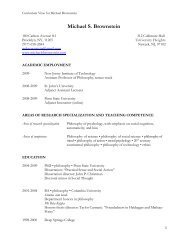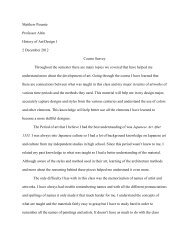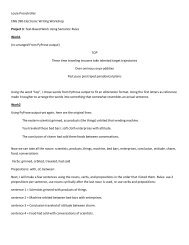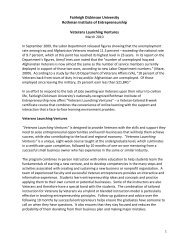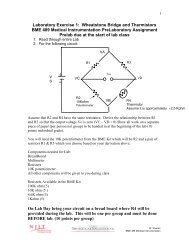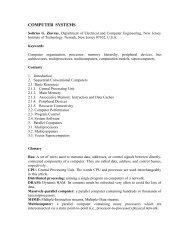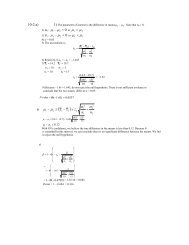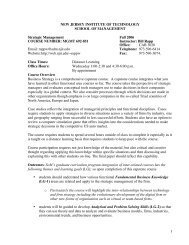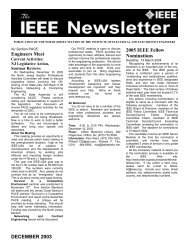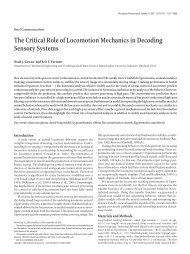Well-conditioned boundary integral formulations for the ... - Njit
Well-conditioned boundary integral formulations for the ... - Njit
Well-conditioned boundary integral formulations for the ... - Njit
Create successful ePaper yourself
Turn your PDF publications into a flip-book with our unique Google optimized e-Paper software.
The maximum relative far-field error, which we denote by ε ∞ ,<br />
ε ∞ = maxˆx |E calc<br />
∞ (ˆx) − E ref<br />
∞ (ˆx)|<br />
maxˆx |E ref , (93)<br />
∞ (ˆx)|<br />
was evaluated in our numerical examples as <strong>the</strong> maximum difference evaluated at sufficiently many<br />
points between far fields E calc<br />
∞ obtained from our numerical solutions and corresponding far fields<br />
E ref<br />
∞ associated with reference solutions. The reference solutions E ref<br />
∞ were computed by Mie series<br />
in <strong>the</strong> case of spherical scatterers and by use of Combined Field Integral Equations based on<br />
<strong>the</strong> <strong>boundary</strong> <strong>integral</strong> operator C k defined in equation (91) and <strong>the</strong> same levels of discretization.<br />
We used accelerator parameters that lead to small computational times and memory usage, while<br />
delivering results with about three digits of accuracy in <strong>the</strong> far-field metrics ε ∞ . Specifically, in all<br />
our numerical experiments we have used <strong>the</strong> following three accelerator parameter values: M eq = 6,<br />
n coll = 10, and n w = 6. The values of <strong>the</strong> remaining accelerator parameter were chosen as follows:<br />
L = 6 <strong>for</strong> scattering problems with D = 10.2λ; L = 12 <strong>for</strong> scattering problems with D = 20.4λ;<br />
L = 16 <strong>for</strong> scattering problems with D = 30.6λ; L = 24 <strong>for</strong> scattering problems with D = 40.8λ; and<br />
L = 30 <strong>for</strong> scattering problems with D = 51.0λ. The computational times and <strong>the</strong> memory usage<br />
reported resulted from a C++ numerical implementation of our various accelerated algorithms on<br />
a workstation with 16 cores, 24 GB RAM and each processor is 2.27 GHz Intel (R) Xeon. All of <strong>the</strong><br />
times reported correspond to runs per<strong>for</strong>med on a single processor running GNU/Linux, and using<br />
<strong>the</strong> GNU/gcc compiler, <strong>the</strong> PETSC 3.0 library <strong>for</strong> <strong>the</strong> fully complex implementation of GMRES,<br />
and <strong>the</strong> FFTW3 library <strong>for</strong> evaluation of FFTs.<br />
We illustrate in Tables 1-3 <strong>the</strong> per<strong>for</strong>mance of our accelerated solvers based on <strong><strong>for</strong>mulations</strong><br />
that involve <strong>the</strong> <strong>boundary</strong> <strong>integral</strong> operators C k , A k,Sik/2 , and B k,2,k,0.4H 2/3 k1/3. In all <strong>the</strong> numerical<br />
experiments presented in those tables we assumed x-polarized plane wave normal incidence. As it<br />
can be seen from <strong>the</strong> results presented in Tables 1-3, <strong>the</strong> numbers of GMRES iterations associated<br />
with solvers based on <strong>the</strong> operators C k and A k,Sik/2 grow with <strong>the</strong> frequency, which is an accord with<br />
<strong>the</strong> <strong>the</strong>oretical predictions <strong>for</strong> spherical scatterers presented in Section 3 <strong>for</strong> spherical scatterers.<br />
In contrast, solvers based on <strong>the</strong> operators B k,2,k,0.4H 2/3 k 1/3 appear to require numbers of GMRES<br />
iterations that do not depend on <strong>the</strong> frequency <strong>for</strong> strictly convex scatterers. Thus, solvers based<br />
on <strong>the</strong> operators B k,2,k,0.4H 2/3 k1/3 should eventually outper<strong>for</strong>m in computing times those based on<br />
<strong>the</strong> operators C k and A k,Sik/2 . Specifically, in <strong>the</strong> high-frequency range presented in Tables 1-3,<br />
<strong>the</strong> solvers based on <strong>the</strong> operators B k,2,k,0.4H 2/3 k 1/3 outper<strong>for</strong>m <strong>the</strong> solvers based on <strong>the</strong> classical<br />
CFIE operators C k in each numerical experiment per<strong>for</strong>med, and <strong>the</strong> gains provided by <strong>the</strong> use<br />
of <strong>the</strong> <strong>for</strong>mer <strong><strong>for</strong>mulations</strong> over those using <strong>the</strong> latter <strong><strong>for</strong>mulations</strong> become more significant with<br />
increased problem size. These gains can be up to factors of 3.3 <strong>for</strong> problems of 51 wavelengths in<br />
electromagnetic size. Also, solvers based on <strong>the</strong> operators A k,Sik/2 consistently outper<strong>for</strong>m those<br />
based on <strong>the</strong> classical CFIE operators C k in terms of computational times, and <strong>the</strong> gains can be up<br />
to factors of 2.6 <strong>for</strong> high-frequencies. Fur<strong>the</strong>rmore, solvers based on <strong>the</strong> operators B k,2,k,0.4H 2/3 k 1/3<br />
outper<strong>for</strong>m those based on <strong>the</strong> operators A k,Sik/2 in terms of computational times, in some cases <strong>for</strong><br />
all frequencies considered (e.g. Table 1 and Table 3), and in <strong>the</strong> o<strong>the</strong>r case <strong>for</strong> higher frequencies<br />
(e.g. Table 2). Given that <strong>the</strong> levels of accuracy reached by our solvers seems to be commensurate<br />
<strong>for</strong> all <strong>the</strong> <strong><strong>for</strong>mulations</strong> considered, <strong><strong>for</strong>mulations</strong> based on <strong>the</strong> operators B k,2,k,0.4H 2/3 k 1/3 appear to<br />
be very suitable <strong>for</strong> high-frequency simulations.<br />
We illustrate in Table 4 statistics of <strong>the</strong> memory requirements and costs of one matrix-vector<br />
product associated to solvers based on <strong><strong>for</strong>mulations</strong> that involve <strong>the</strong> <strong>boundary</strong> <strong>integral</strong> operators C k ,<br />
A k,Sik/2 , and B k,2,k,0.4H 2/3 k1/3. As it can be seen, <strong>the</strong> cost of one matrix-vector product of all of <strong>the</strong>se<br />
36



